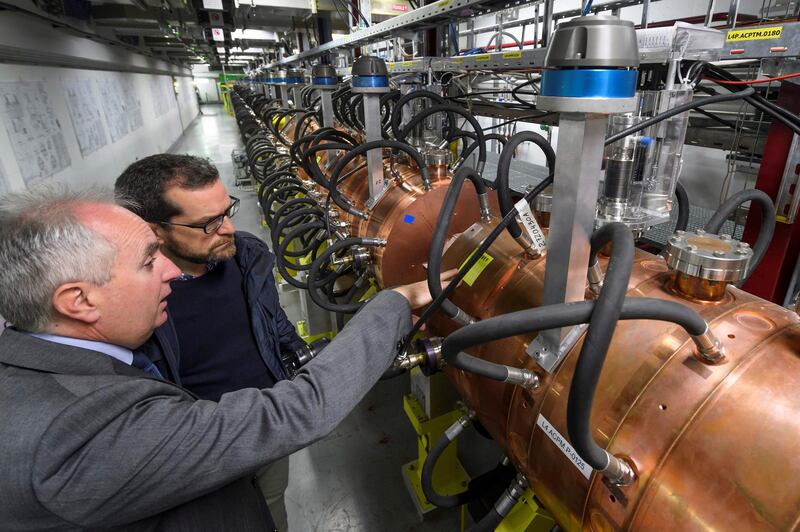It’s a classic Hollywood plot-line: the lone hero who emerges from nowhere to pull off a daring rescue. Now there’s talk that just such a figure is needed to rescue science.
The idea of science being in trouble may seem hard to square with the steady flow of advances making headlines each day. But these mask an inconvenient truth: that they’re mostly pygmy steps dressed up to look like giant leaps.
From medicine and public health to particle physics and cosmology, answers to big questions first raised decades ago remain as far away as ever.
Despite intense research, the global pandemics of obesity and Alzheimer’s continue unabated, while the “genetic revolution” that promised cures for major diseases has failed to deliver.
Meanwhile, scientists trying to fathom the mysteries of the cosmos are lost in space. They know the universe is expanding, but have no idea what’s propelling it. They suspect it’s filled with invisible stuff called dark matter, but they don’t know what it’s made from.
The leading contender was a type of so-called supersymmetric particle, widely expected to turn up in experiments at the Large Hadron Collider (LHC), the giant particle accelerator near Geneva, Switzerland. But it doesn’t seem to be exist.
Earlier this month a team using the most sensitive detector ever built to identify dark matter admitted they’d come up empty.
Scientists in many areas are growing increasingly worried that without some breakthroughs soon, budgets will be cut, and jobs axed.
The dark clouds are already gathering. According to the leading science journal Nature, plans to build a successor to the LHC in Japan are being scaled back, and it is now unlikely to be built before 2030.
It’s hard to escape the suspicion that over the last few decades, the scientific enterprise has taken a wrong turn.
Many blame the rise of the “publish or perish” syndrome, which encourages scientists to focus on ho-hum problems with a high chance of giving publishable results – and thus more funding.
But now one researcher is proposing a way to break the impasse. The scientific community, he says, should pay more heed to lone researchers with radical ideas.
Describing his proposal in the current edition of Big Think Edge, Harvard-trained mathematician and economist Dr Eric Weinstein argues that science stopped believing in the fabled lone genius after the death of Einstein 60 years ago.
Ever since, the focus has been on whole teams of researchers working together to crack problems.
But according to Dr Weinstein, that’s also led to group-think and stagnation.
Ironically, these blights on creativity are particularly prevalent in the quest to solve cosmic problems Einstein left for future generations – and which remain as baffling as ever.
“The question at this moment”, says Dr Weinstein, “Is should we be looking more to the heterodox – running the risk of craziness and cranks – or should we be looking more to the traditional community, which seems to have gotten itself into a cul-de-sac”.
Dr Weinstein has scientific history on his side. Many of the biggest breakthrough have come from outsiders.
Charles Darwin, the founder of evolution theory, was trained as a doctor and used his private wealth to fund his studies. Francis Crick, co-discoverer of the structure of DNA and the nature of genes, was a physicist who thought biologists weren’t bold enough to find the secret of life.
Einstein himself was a patent clerk with no academic connections when he put forward his theory of relativity.
Yet lone voices often struggle to make themselves heard in scientific debates - as Dr Weinstein himself knows.
Having left academia to work in finance, he has been working on his own cosmic theories, and has given invited lectures to physicists at Oxford University.
The reception has been anything but warm. While some critics of his ideas have focused on genuine questions about his ideas, others seem simply to resent an “outsider” wading in to their field.
It's a common experience – even for scientific celebrities who dare to question accepted wisdom. Despite winning the 1999 Nobel Prize for physics, the Dutch theorist Gerard 't Hooft has also gone on record about his struggles to get his own theories of the cosmos taken seriously.
Nor is fundamental physics alone in having problems coping with radical ideas. For years, some medical scientists have harboured doubts about the standard explanation for Alzheimer’s Disease.
According to this, the dementia is the result of a build-up of a sticky protein called amyloid-beta, creating so-called plaques and tangles in brain cells, which then malfunction and die.
Yet despite trials of dozens of different therapies based on this idea, not one has worked.
For over 25 years, Dr Ruth Itzhaki, a former physicist, has been amassing evidence that Alzheimer’s may really be caused by a virus lurking in the brain.
Last year the highly respected Journal of Alzheimer's Disease published an editorial signed by dozens of researchers calling for the idea to be taken more seriously.
Yet despite this – and the abject failure of the standard theory to produce results - Dr Itzhaki has been repeatedly denied funding for clinical work.
Cynics point out there is more at stake here than loss of face among established researchers. If the virus theory gets support – or worse still, positive results – it could mean the end of funding for their own research.
Some researchers also point out the difficulties of getting funding for rival theories when the approval committees for grants are dominated by advocates of the standard view.
Clearly it’s neither rational nor possible to take every maverick idea seriously. Yet at the same time, it makes no sense to reject ideas simply because they come from outsiders.
The real litmus tests of theories worth taking seriously is whether they make testable predictions. And there are plenty that do.
It’s hard to imagine much harm would be done by spending some of the vast sums lavished on today’s faltering theories on testing promising alternatives. The chances of success may be low, but the payoff could literally be cosmic.
Robert Matthews is Visiting Professor of Science at Aston University, Birmingham, UK






